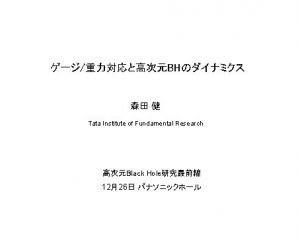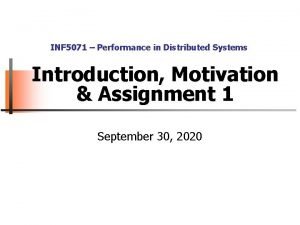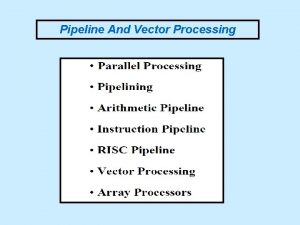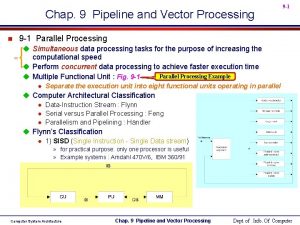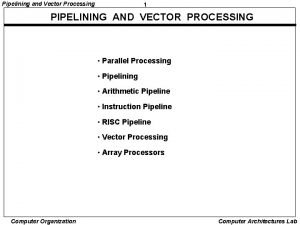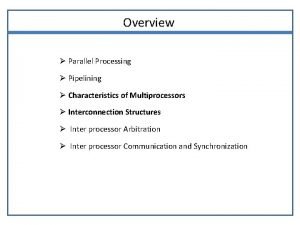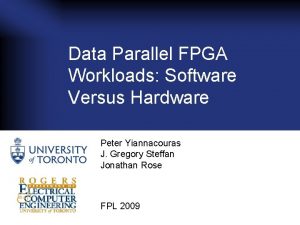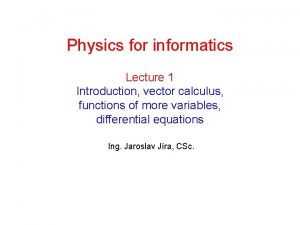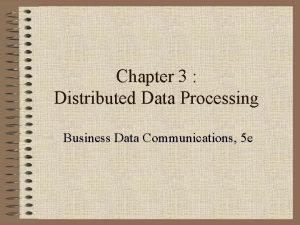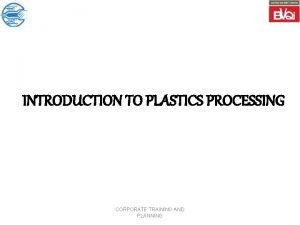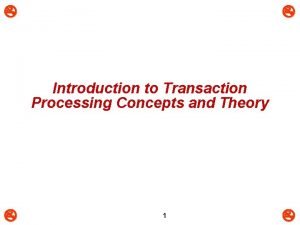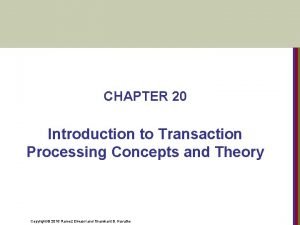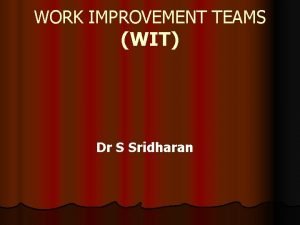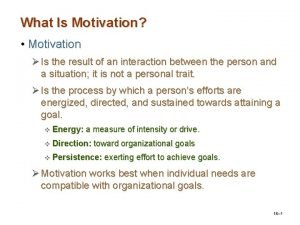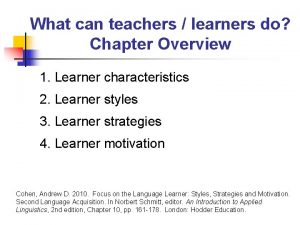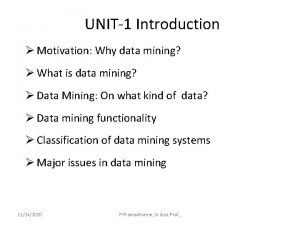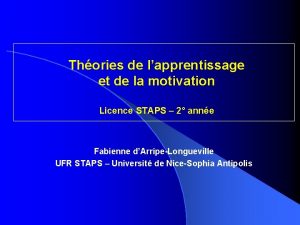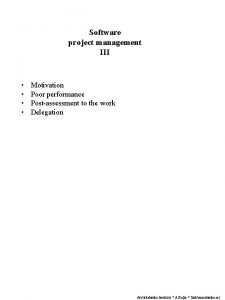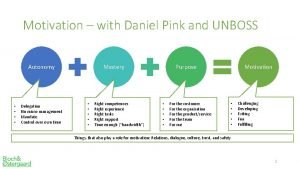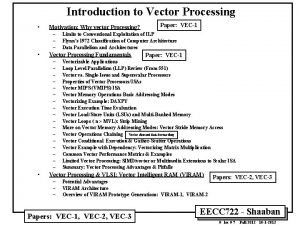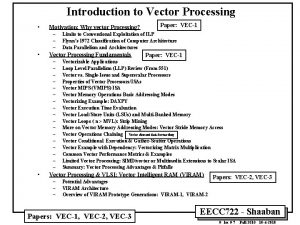Introduction to Vector Processing Motivation Why vector Processing









![LLP Analysis Example 1 • In the loop: for (i=1; i<=100; i=i+1) { A[i+1] LLP Analysis Example 1 • In the loop: for (i=1; i<=100; i=i+1) { A[i+1]](https://slidetodoc.com/presentation_image_h/7fedb8a3116e805be06bd4123d96e899/image-10.jpg)

![LLP Analysis Example 2 Original Loop: Iteration 1 for (i=1; i<=100; i=i+1) { A[i] LLP Analysis Example 2 Original Loop: Iteration 1 for (i=1; i<=100; i=i+1) { A[i]](https://slidetodoc.com/presentation_image_h/7fedb8a3116e805be06bd4123d96e899/image-12.jpg)










































![Vector Example with Dependency: Matrix Multiplication /* Multiply a[m][k] * b[k][n] to get c[m][n] Vector Example with Dependency: Matrix Multiplication /* Multiply a[m][k] * b[k][n] to get c[m][n]](https://slidetodoc.com/presentation_image_h/7fedb8a3116e805be06bd4123d96e899/image-55.jpg)
![Scalar Matrix Multiplication /* Multiply a[m][k] * b[k][n] to get c[m][n] */ for (i=1; Scalar Matrix Multiplication /* Multiply a[m][k] * b[k][n] to get c[m][n] */ for (i=1;](https://slidetodoc.com/presentation_image_h/7fedb8a3116e805be06bd4123d96e899/image-56.jpg)


![/* Multiply a[m][k] * b[k][n] to get c[m][n] */ for (i=1; i<m; i++) MVL /* Multiply a[m][k] * b[k][n] to get c[m][n] */ for (i=1; i<m; i++) MVL](https://slidetodoc.com/presentation_image_h/7fedb8a3116e805be06bd4123d96e899/image-59.jpg)
























- Slides: 83

Introduction to Vector Processing • Motivation: Why vector Processing? – – – • • Limits to Conventional Exploitation of ILP Flynn’s 1972 Classification of Computer Architecture Data Parallelism and Architectures Vector Processing Fundamentals – – – – – Paper: VEC 1 Vectorizable Applications Loop Level Parallelism (LLP) Review (From 551) Vector vs. Single Issue and Superscalar Processors Properties of Vector Processors/ISAs Vector MIPS (VMIPS) ISA Vector Memory Operations Basic Addressing Modes Vectorizing Example: DAXPY Vector Execution Time Evaluation Vector Load/Store Units (LSUs) and Multi Banked Memory Vector Loops ( n > MVL): Strip Mining More on Vector Memory Addressing Modes: Vector Stride Memory Access Vector Operations Chaining Vector element data forwarding Vector Conditional Execution & Gather Scatter Operations Vector Example with Dependency: Vectorizing Matrix Multiplication Common Vector Performance Metrics & Examples Limited Vector Processing: SIMD/vector or Multimedia Extensions to Scalar ISA Summary: Vector Processing Advantages & Pitfalls Vector Processing & VLSI: Vector Intelligent RAM (VIRAM) – – – Potential Advantages VIRAM Architecture Overview of VIRAM Prototype Generations: VIRAM 1, VIRAM 2 Papers: VEC 1, VEC 2, VEC 3 Papers: VEC 2, VEC 3 EECC 722 Shaaban # lec # 7 Fall 2011 10 3 2011

Motivation for Vector Processing: Problems with Superscalar approach • Limits to conventional exploitation of ILP: 1) Pipelined clock rate: Increasing clock rate requires deeper pipelines with longer pipeline latency which increases the CPI increase (longer branch penalty , other hazards). 2) Instruction Issue Rate: Limited instruction level parallelism (ILP) reduces actual instruction issue/completion rate. (vertical & horizontal waste) 3) Cache hit rate: Data intensive scientific programs have very large data working sets accessed with poor locality; others have continuous data streams (multimedia) and hence poor locality. (poor memory latency hiding). 4) Data Parallelism: Poor exploitation of data parallelism present in many scientific and multimedia applications, where similar independent computations are performed on large arrays of data (Limited ISA, hardware support). • As a result, actual achieved performance is much less than peak potential performance and low computational energy efficiency (computations/watt) EECC 722 Shaaban # lec # 7 Fall 2011 10 3 2011

X 86 CPU Cache/Memory Performance Example: AMD Athlon T Bird Vs. Intel PIII, Vs. P 4 AMD Athlon T Bird 1 GHZ L 1: 64 K INST, 64 K DATA (3 cycle latency), both 2 way L 2: 256 K 16 way 64 bit Latency: 7 cycles L 1, L 2 on chip Intel P 4, 1. 5 GHZ L 1: 8 K INST, 8 K DATA (2 cycle latency) both 4 way 96 KB Execution Trace Cache L 2: 256 K 8 way 256 bit , Latency: 7 cycles Data working set larger than L 2 L 1, L 2 on chip Intel PIII 1 GHZ L 1: 16 K INST, 16 K DATA (3 cycle latency) both 4 way L 2: 256 K 8 way 256 bit , Latency: 7 cycles L 1, L 2 on chip Impact of long memory latency for large data working sets Source: http: //www 1. anandtech. com/showdoc. html? i=1360&p=15 From 551 EECC 722 Shaaban # lec # 7 Fall 2011 10 3 2011

Flynn’s 1972 Classification of Computer Architecture i. e single threaded Uniprocessor SISD SIMD MISD MIMD • Single Instruction stream over a Single Data stream (SISD): Conventional sequential machines (Superscalar, VLIW). • Single Instruction stream over Multiple Data streams (SIMD): Vector computers, array of synchronized processing Data Parallel or Data Streaming elements. (exploit data parallelism) AKA Architectures • Multiple Instruction streams and a Single Data stream (MISD): Systolic arrays for pipelined execution. • Multiple Instruction streams over Multiple Data streams (MIMD): Parallel computers: Parallel Processor Systems: Exploit Thread Level Parallelism (TLP) • Shared memory multiprocessors (e. g. SMP, CMP, NUMA, SMT) • Multicomputers: Unshared distributed memory, message passing used instead (Clusters) Instruction stream = Hardware context or thread From 756 Lecture 1 EECC 722 Shaaban # lec # 7 Fall 2011 10 3 2011

• Data Parallel Systems SIMD in Flynn taxonomy Programming model: Data Parallel – Operations performed in parallel on each element of data structure i. e elements of arrays or vectors – Logically single thread of control, performs sequential or parallel steps – Conceptually, a processing element (PE) or processor is associated with each data element • Architectural model – Array of many simple, cheap processors each with little memory • Processors don’t sequence through instructions Control processor does that – Attached to a control processor that issues instructions – Specialized and general communication, cheap global synchronization • Example machines: – – – Thinking Machines CM 1, CM 2 (and CM 5) Maspar MP 1 and MP 2, Current Variations: IBM’s Cell Architecture, Graphics Processor Units (GPUs) • Difference: PE’s are full processors optimized for data parallel computations. From 756 Lecture 1 PE = Processing Element SIMD (array) Machine EECC 722 Shaaban # lec # 7 Fall 2011 10 3 2011

• • Alternative Model: Vector Processing Vector processing exploits data parallelism by performing the same computation on linear arrays of numbers "vectors” using one instruction. The maximum number of elements in a vector supported by a vector ISA is referred to as the Maximum Vector Length (MVL). Typical MVL= 64 128 Range 64 4996 Per scalar instruction Scalar ISA (RISC or CISC) SCALAR (1 operation) VECTOR (N operations) (Vector vector instruction shown) Vector ISA v 1 v 2 r 1 + + r 3 v 3 Add vector Add. d F 3, F 1, F 2 VEC 1 Per vector instruction vector length Vector Registers addv. d v 3, v 1, v 2 Typical MVL = 64 (Cray) v = vector Up to Maximum Vector Length (MVL) EECC 722 Shaaban # lec # 7 Fall 2011 10 3 2011

Vector (Vectorizable) Applications with high degree of data parallelism (loop level parallelism), thus suitable for vector processing. Not Limited to scientific computing • • • • Astrophysics Atmospheric and Ocean Modeling Bioinformatics Biomolecular simulation: Protein folding Computational Chemistry Computational Fluid Dynamics Computational Physics Computer vision and image understanding Data Mining and Data intensive Computing Engineering analysis (CAD/CAM) Global climate modeling and forecasting Material Sciences Military applications Quantum chemistry VLSI design Multimedia Processing (compress. , graphics, audio synth, image proc. ) • • Standard benchmark kernels (Matrix Multiply, FFT, Convolution, Sort) Lossy Compression (JPEG, MPEG video and audio) Lossless Compression (Zero removal, RLE, Differencing, LZW) Cryptography (RSA, DES/IDEA, SHA/MD 5) Speech and handwriting recognition Operating systems/Networking (memcpy, memset, parity, checksum) Databases (hash/join, data mining, image/video serving) Language run time support (stdlib, garbage collection) EECC 722 Shaaban # lec # 7 Fall 2011 10 3 2011

Data Parallelism & Loop Level Parallelism (LLP) • • Data Parallelism: Similar independent/parallel computations on different elements of arrays that usually result in independent (or parallel) loop iterations when such computations are implemented as sequential programs. In scalar code A common way to increase parallelism among instructions is to exploit data parallelism among independent iterations of a loop Usually: Data Parallelism ® LLP (e. g exploit Loop Level Parallelism, LLP). – One method covered earlier to accomplish this is by unrolling the loop either statically by the compiler, or dynamically by hardware, which increases the size of the basic block present. This resulting larger basic block provides more instructions that can be scheduled or re ordered by the compiler/hardware to eliminate more stall cycles. • The following loop has parallel loop iterations since computations in each iterations are data parallel and are performed on different elements of the arrays. Scalar Code • for (i=1; i<=1000; i=i+1; ) x[i] = x[i] + y[i]; 4 vector instructions: LV LV ADDV SV Load Vector X Load Vector Y Add Vector X, X, Y Store Vector X Vector Code In supercomputing applications, data parallelism/LLP has been traditionally exploited by vector ISAs/processors, utilizing vector instructions – Vector instructions operate on a number of data items (vectors) producing a vector of elements not just a single result value. The above loop might require just four such instructions. Assuming Maximum Vector Length(MVL) = 1000 is supported otherwise a vector loop (i. e strip mining) is needed, more on this later From 551 EECC 722 Shaaban # lec # 7 Fall 2011 10 3 2011

• Loop Level Parallelism (LLP) Analysis Loop Level Parallelism (LLP) analysis focuses on whether data accesses in later iterations of a loop are data dependent on data values produced in earlier iterations and possibly making loop iterations independent (parallel). e. g. in Usually: for (i=1; i<=1000; i++) x[i] = x[i] + s; Data Parallelism ® LLP in scalar code Iteration # S 1 (Body of Loop) 1 2 3 …. . 1000 S 1 S 1 … S 1 Dependency Graph the computation in each iteration is independent of the previous iterations and the loop is thus parallel. The use of X[i] twice is within a single iteration. Þ Thus loop iterations are parallel (or independent from each other). Classification of Date Dependencies in Loops: • • Loop carried Data Dependence: A data dependence between different loop iterations (data produced in an earlier iteration used in a later one). Not Loop carried Data Dependence: Data dependence within the same loop iteration. LLP analysis is important in software optimizations such as loop unrolling since it usually requires loop iterations to be independent (and in vector processing). LLP analysis is normally done at the source code level or close to it since assembly language and target machine code generation introduces loop carried name dependence in the registers used in the loop. – Instruction level parallelism (ILP) analysis, on the other hand, is usually done when instructions are generated by the compiler. From 551 EECC 722 Shaaban # lec # 7 Fall 2011 10 3 2011
![LLP Analysis Example 1 In the loop for i1 i100 ii1 Ai1 LLP Analysis Example 1 • In the loop: for (i=1; i<=100; i=i+1) { A[i+1]](https://slidetodoc.com/presentation_image_h/7fedb8a3116e805be06bd4123d96e899/image-10.jpg)
LLP Analysis Example 1 • In the loop: for (i=1; i<=100; i=i+1) { A[i+1] = A[i] + C[i]; /* S 1 */ B[i+1] = B[i] + A[i+1]; } /* S 2 */ } Loop carried Dependence i Iteration # Not Loop Carried Dependence (within the same iteration) i+1 S 1 A i+1 S 2 (Where A, B, C are distinct non overlapping arrays) B i+1 S 2 Dependency Graph – S 2 uses the value A[i+1], computed by S 1 in the same iteration. This data dependence is within the same iteration (not a loop-carried dependence). Þ does not prevent loop iteration parallelism. i. e. S 1 ® S 2 on A[i+1] Not loop carried dependence – S 1 uses a value computed by S 1 in the earlier iteration, since iteration i computes A[i+1] read in iteration i+1 (loop-carried dependence, prevents parallelism). The same applies for S 2 for B[i] and B[i+1] i. e. S 1 ® S 1 on A[i] Loop carried dependence S 2 ® S 2 on B[i] Loop carried dependence Þ These two data dependencies are loop carried spanning more than one iteration (two iterations) preventing loop parallelism. In this example the loop carried dependencies form two dependency chains starting from the very first iteration and ending at the last iteration From 551 EECC 722 Shaaban # lec # 7 Fall 2011 10 3 2011

LLP Analysis Example 2 Dependency Graph Iteration # • In the loop: for (i=1; i<=100; i=i+1) { A[i] = A[i] + B[i]; B[i+1] = C[i] + D[i]; } /* S 1 */ /* S 2 */ Loop carried Dependence i i+1 S 1 B i+1 S 2 – S 1 uses the value B[i] computed by S 2 in the previous iteration (loop-carried dependence) i. e. S 2 ® S 1 on B[i] Loop carried dependence – This dependence is not circular: • S 1 depends on S 2 but S 2 does not depend on S 1. – Can be made parallel by replacing the code with the following: Scalar Code: Loop Start up code A[1] = A[1] + B[1]; for (i=1; i<=99; i=i+1) { Vectorizable B[i+1] = C[i] + D[i]; code Parallel loop iterations A[i+1] = A[i+1] + B[i+1]; (data parallelism in computation exposed in loop code) } B[101] = C[100] + D[100]; Scalar Code: Loop Completion code From 551 EECC 722 Shaaban # lec # 7 Fall 2011 10 3 2011
![LLP Analysis Example 2 Original Loop Iteration 1 for i1 i100 ii1 Ai LLP Analysis Example 2 Original Loop: Iteration 1 for (i=1; i<=100; i=i+1) { A[i]](https://slidetodoc.com/presentation_image_h/7fedb8a3116e805be06bd4123d96e899/image-12.jpg)
LLP Analysis Example 2 Original Loop: Iteration 1 for (i=1; i<=100; i=i+1) { A[i] = A[i] + B[i]; B[i+1] = C[i] + D[i]; } Iteration 2 S 1 A[1] = A[1] + B[1]; A[2] = A[2] + B[2]; S 2 B[2] = C[1] + D[1]; B[3] = C[2] + D[2]; (one less iteration) Loop carried Dependence Iteration 1 A[1] = A[1] + B[1]; A[2] = A[2] + B[2]; B[2] = C[1] + D[1]; B[3] = C[2] + D[2]; From 551 . . . Iteration 99 Iteration 100 A[99] = A[99] + B[99]; A[100] = A[100] + B[100]; B[100] = C[99] + D[99]; B[101] = C[100] + D[100]; Scalar Code: Loop Start up code A[1] = A[1] + B[1]; for (i=1; i<=99; i=i+1) { B[i+1] = C[i] + D[i]; Vectorizable A[i+1] = A[i+1] + B[i+1]; } B[101] = C[100] + D[100]; Scalar Code: Loop Completion code Modified Parallel Loop: Loop Start up code /* S 1 */ /* S 2 */ . . Not Loop Carried Dependence Iteration 98 code Iteration 99 A[99] = A[99] + B[99]; A[100] = A[100] + B[100]; B[100] = C[99] + D[99]; B[101] = C[100] + D[100]; Loop Completion code EECC 722 Shaaban # lec # 7 Fall 2011 10 3 2011

Properties of Vector Processors/ISAs • Each result (element) in a vector operation is independent of previous results (Data Parallelism, LLP exploited) => Multiple pipelined Functional units (lanes) usually used, vector compiler ensures no dependencies between computations on elements of a single vector instruction => Higher clock rate (less complexity) • Vector instructions access memory with known patterns: => Highly interleaved memory with multiple banks used to provide the high bandwidth needed and hide memory latency. => Amortize memory latency of over many vector elements. => No (data) caches usually used. (Do use instruction cache) Thus more predictable performance i. e. lower effective impact of memory latency Up to MVL computations • A single vector instruction implies a large number of computations (replacing loops or reducing number of iterations needed) By a factor of MVL => Fewer instructions fetched/executed, TLB look ups…. => Reduces branches and branch problems (control hazards) in pipelines. As if loop unrolling by default MVL times? EECC 722 Shaaban # lec # 7 Fall 2011 10 3 2011

Vector vs. Single Issue Scalar Processor Vector Single issue Scalar l l l One instruction fetch, decode, dispatch per operation Arbitrary register accesses, adds area and power Loop unrolling and software pipelining for high performance increases instruction cache footprint All data passes through cache; waste power if no temporal locality One TLB lookup per load or store • • • l Off chip access in whole cache lines One instruction fetch, decode, dispatch per vector (up to MVL elements) Structured register accesses Smaller code for high performance, less power in instruction cache misses Bypass cache (for data) One TLB lookup per group of loads or stores Move only necessary data across chip boundary EECC 722 Shaaban # lec # 7 Fall 2011 10 3 2011

Vector vs. Superscalar Processors Vector Superscalar • • Control logic grows quad ratically with issue width Control logic consumes energy regardless of available parallelism • • • Control logic grows linearly with issue width Vector unit switches off when not in use Higher energy efficiency Low Computational power efficiency (computations/watt) Dynamic nature makes real time performance less predictable Speculation to increase visible parallelism wastes energy and adds complexity • More predictable real time performance • Vector instructions expose data parallelism without speculation Software control of speculation when desired: – Whether to use vector mask or compress/expand for conditionals • The above differences are in addition to the “Vector vs. Single Issue Scalar Processor” differences (from last slide) EECC 722 Shaaban # lec # 7 Fall 2011 10 3 2011

Changes to Scalar Processor to Run Vector Instructions 1 2 • A vector processor typically consists of: 1 a pipelined scalar unit plus 2 a vector unit. • The scalar unit is basically not different than advanced pipelined CPUs, commercial vector machines have included both out of order scalar units (NEC SX/5) and VLIW scalar units (Fujitsu VPP 5000). • Computations that don’t run in vector mode don’t have high ILP, so can make scalar CPU simple. • The vector unit supports a vector ISA including decoding of vector instructions which includes: 1 – Vector functional units. Multiple Pipelined Functional Units (FUs) or lanes – ISA vector register bank. Each has MVL elements 2 MVL Bits – Vector control registers 3 • e, . g Vector Length Register (VLR), Vector Mask (VM) 1 1 1 0 0 …. . 01 Vector Mask (VM) Register – Vector memory Load Store Units (LSUs). – Multi banked main memory To provide the very high data bandwidth needed 5 • Send scalar registers to vector unit (for vector scalar ops). • Synchronization for results back from vector register, including exceptions. 4 6 + System component interconnects EECC 722 Shaaban # lec # 7 Fall 2011 10 3 2011

Basic Types of Vector Architecture/ISAs • Types of architecture/ISA for vector processors: – Memory-memory Vector ISAs/Processors: All vector operations are memory to memory (No vector ISA registers) – Vector-register ISAs/Processors: All vector operations between vector registers (except vector load and store) • Vector equivalent of load store scalar GPR architectures (ISAs) • Includes all vector machines since the late 1980 (Cray, Convex, Fujitsu, Hitachi, NEC) • We assume vector register for rest of the lecture. EECC 722 Shaaban # lec # 7 Fall 2011 10 3 2011

Basic Structure of Vector Register Architecture Multi Banked memory for high bandwidth and latency hiding 5 4 6 System Interconnects 1 Pipelined Vector Functional Units Vector Load Store Units (LSUs) MVL elements (64 bits each) 2 3 Vector Control Registers VLR Vector Length Register MVL = Maximum Vector Length MVL bits VEC 1 VM Vector Mask Register Typical MVL = 64 (Cray) MVL range 64 4096 (4 K) EECC 722 Shaaban # lec # 7 Fall 2011 10 3 2011

Components of Vector Processor 1 • Vector Functional Units (FUs): Fully pipelined, start new operation every clock – Typically 4 to 8 Fus (or lanes): FP add, FP mult, FP reciprocal (1/X), integer add, logical, shift; may have multiple of same unit (multiple lanes of the same type) More on lanes later 2 • • ISA Vector Register Bank: Fixed length bank holding vector ISA registers – Has at least 2 read and 1 write ports – Typically 8 32 vector registers, each holding MVL = 64 128 elements (typical, up to 4 K possible) 64 bit elements. ISA Scalar registers: single element for FP scalar or address. 3 • Vector Control Registers: Vector Length Register (VLR), Vector Mask Register (VM). 4 • Vector Load-Store Units (LSUs): fully pipelined unit to load or store a vector; may have multiple LSUs. 5 • Multi Banked memory: Multi Banked memory for high throughput (bandwidth) and long latency hiding. 6 • System Interconnects: Cross bar to connect FUs , LSUs, registers, memory. VEC 1 EECC 722 Shaaban # lec # 7 Fall 2011 10 3 2011

Vector ISA Issues: How To Pick Maximum Vector Length (MVL)? Vector Instruction Processing Time (or latency): Startup Time Vector elements computation time • Longer good because: Pipelined vector functional One cycle per result vector unit (FU) startup latency element (up to MVL cycles) (fill cycles) 1) Hide vector startup time 2) Lower instruction bandwidth Fewer instructions fetched for a given computation 3) Tiled access to memory reduce scalar processor memory bandwidth needs 4) If known maximum length of app. is < MVL, no strip mining (vector loop) overhead is needed. 5) Better spatial locality for memory access • Longer not much help because: 1) Diminishing returns on overhead savings as keep doubling number of elements. 2) Need natural application vector length to match physical vector register length, or no help i. e MVL VEC 1 EECC 722 Shaaban # lec # 7 Fall 2011 10 3 2011

Media Processing: Vectorizable? Vector Lengths? Natural Application Computational Kernel • • Vector length MVL? Matrix transpose/multiply # vertices at once DCT (video, communication) image width FFT (audio) 256 1024 Motion estimation (video)image width, iw/16 Gamma correction (video) image width Haar transform (media mining) image width Median filter (image processing) image width Separable convolution (img. proc. ) image width (from Pradeep Dubey - IBM, http: //www. research. ibm. com/people/p/pradeep/tutor. html) EECC 722 Shaaban # lec # 7 Fall 2011 10 3 2011

Vector Implementation • Vector register file: – Each register is an array of MVL elements. – Size of each register is determined by the maximum vector length (MVL) supported by the implemented vector ISA. – Vector Length Register (VLR) determines the actual vector length Vector used for a particular vector operation or instruction. Control Registers – Vector Mask Register (VM) determines which elements of a vector MVL Bits will be computed. • Multiple parallel execution units = “lanes” (sometimes Vector called “pipelines” or “pipes”) of the same type: Lanes – Multiples pipelined functional units (lanes) are each assigned a number of computations of a single vector instruction. Where N is the number of lanes supported by the vector processor Thus, supporting multiple lanes in a vector processor reduces vector instruction latency by producing multiple elements of the result vector per cycle (after fill cycles). - Having multiple lanes, however, does not reduce vector startup time (vector unit fill cycles). Processing time for a vector instruction in cycles EECC 722 Shaaban # lec # 7 Fall 2011 10 3 2011

Structure of a Vector Unit Containing Four Lanes Number of Lanes in a vector unit (processor): The number of vector functional units of the same type that are each assigned a number of computations of the same vector instruction e. g ADDV e. g MULV VEC 1 What about MVL lanes ? EECC 722 Shaaban # lec # 7 Fall 2011 10 3 2011

Using Multiple Lanes (Vector Functional Units) to Improve Performance of A Single Vector Add Instruction Single Lane: For vectors with nine elements (as shown) Time needed = 9 cycles + startup (a) has a single add pipeline and can complete one addition per cycle. The machine shown in (b) has four add pipelines and can complete four additions per cycle. Four Lanes: For vectors with nine elements Time needed = 3 cycles + startup One Lane Four Lanes MVL lanes? Data parallel system, SIMD array? EECC 722 Shaaban # lec # 7 Fall 2011 10 3 2011

Example Vector Register Architectures (MVL) (LSUs) Peak 133 MFLOPS Vector processor family Used in Earth Simulator VEC 1 VMIPS = Vector MIPS EECC 722 Shaaban # lec # 7 Fall 2011 10 3 2011

8 Vector Registers V 0 V 7 MVL = 64 (Similar to Cray) The VMIPS Vector FP Instructions Vector FP Vector Memory Access Addressing Modes 1 Unit Stride Access Vector Memory 2 Constant Stride Access 3 Variable Stride Access (indexed) Vector Index Vector Mask (VM) Vector Length (VLR) VEC 1 Vector Control Registers: VM = Vector Mask VLR = Vector Length Register EECC 722 Shaaban # lec # 7 Fall 2011 10 3 2011

• • Basic Vector Memory Access Addressing Modes 1 Load/store operations move groups of data between registers and memory Three types of addressing: – Unit stride Fastest memory access Sequential element access, i. e Stride = 1 LV (Load Vector), SV (Store Vector): LV V 1, R 1 SV R 1, V 1 2 Load vector register V 1 from memory starting at address R 1 Store vector register V 1 into memory starting at address R 1. – Non unit (constant) stride LVWS (Load Vector With Stride), SVWS (Store Vector With Stride): LVWS V 1, (R 1, R 2) SVWS (R 1, R 2), V 1 3 Load V 1 from address at R 1 with stride in R 2, i. e. , R 1+i × R 2. Store V 1 from address at R 1 with stride in R 2, i. e. , R 1+i × R 2. – Indexed (gather scatter) (i size of element) Or Variable stride • Vector equivalent of register indirect • Good for sparse arrays of data • Increases number of programs that vectorize LVI (Load Vector Indexed or Gather), SVI (Store Vector Indexed or Scatter): LVI V 1, (R 1+V 2) Load V 1 with vector whose elements are at R 1+V 2(i), i. e. , V 2 is an index. SVI (R 1+V 2), V 1 Store V 1 to vector whose elements are at R 1+V 2(i), i. e. , V 2 is an index. VEC 1 Stride = Distance in elements between consecutive vector elements loaded or stored by a vector memory access instruction EECC 722 Shaaban # lec # 7 Fall 2011 10 3 2011

Scalar Vs. Vector Code Example DAXPY (Y = a * X + Y) * Assuming vectors X, Y are length 64 =MVL L. D F 0, a ; load scalar a LV V 1, Rx ; load vector X Scalar vs. Vector MULVS. D V 2, V 1, F 0 ; vector scalar mult. LV V 3, Ry ; load vector Y ADDV. D V 4, V 2, V 3 ; add SV Ry, V 4 ; store the result VLR = 64 VM = (1, 1, 1, 1. . 1) L. D DADDIU loop: L. D MUL. D ADD. D S. D DADDIU DSUBU BNEZ VEC 1 F 0, a R 4, Rx, #512 F 2, 0(Rx) F 2, F 0, F 2 F 4, 0(Ry) F 4, F 2, F 4 , 0(Ry) Rx, #8 Ry, #8 R 20, R 4, Rx R 20, loop As if the scalar loop code was unrolled MVL = 64 times: Every vector instruction replaces 64 scalar instructions. ; last address to load ; load X(i) ; a*X(i) ; load Y(i) ; a*X(i) + Y(i) ; store into Y(i) ; increment index to X ; increment index to Y ; compute bound ; check if done Unroll scalar loop code? What does loop unrolling accomplish? Scalar Vs. Vector Code 578 (2+9*64) vs. 321 (1+5*64) ops (1. 8 X) 578 (2+9*64) vs. 6 instructions (96 X) 64 operation vectors + no loop overhead also 64 X fewer pipeline hazards EECC 722 Shaaban # lec # 7 Fall 2011 10 3 2011

In seconds or cycles Vector Execution Time/Performance • Time = f(vector length, data dependencies, struct. hazards, C) • Initiation rate: rate that FU consumes vector elements. (= number of lanes; usually 1 or 2 on Cray T 90) • Convoy: a set of vector instructions that can begin execution in approximately the same clock cycle (no structural or data hazards). • Chime: approx. time in cycles to produce a vector element result (usually = number of convoys in vector code). Assuming one lane is used/ignore startup • m convoys take Tchime=m cycles (or 1 chime); if each vector length is n, then they take approx. m x n clock cycles (ignores overhead; one lane; good approximation for long vectors) i. e vector functional unit Convoy startup time etc. Assuming vector length, n £ MVL 1: LV V 1, Rx ; load vector X 4: SV Ry, V 4 ; store the result 4 conveys, 1 lane, VL= n = 64 2: MULV V 2, F 0, V 1 ; vector scalar mult. => 4 x 64 = 256 cycles (or m= 4 cycles per result LV V 3, Ry ; load vector Y vector element) 3: ADDV V 4, V 2, V 3 ; add VEC 1 DAXPY Ignoring vector startup time, n <= MVL EECC 722 Shaaban # lec # 7 Fall 2011 10 3 2011

DAXPY (Y = a * X + Y) Timing (One LSU, One Lane, No Vector Chaining, Ignoring Startup) n £ MVL From Last Slide: Time in Cycles = Number of Convoys x Vector Length = Tchime x n = m x n Convoy 1: LV V 1, Rx ; load vector X m= 4 conveys, 1 lane, VL = n = 64 => 4 x 64 = 256 cycles (or Tchime= 4 cycles per result vector element) 2: MULV V 2, F 0, V 1 ; vector scalar mult. LV V 3, Ry ; load vector Y 3: ADDV V 4, V 2, V 3 ; add 4: SV Ry, V 4 ; store the result mxn 1 n n LV V 1, Rx m = 4 Convoys or Tchime = 4 cycles per element n elements take = m x n = 4 n cycles For n = VL = MVL = 64 it takes 4 x 64 = 256 cycles n 2 MULV V 2, F 0, V 1 LV V 3, Ry 2 n Tchime = m = 4 n 3 ADDV V 4, V 2, V 3 n = vector length = VL = number of elements in vector m or Tchime = Number of convoys VEC 1 4 convoys x n = 4 x 64 = 256 cycles n What if multiple lanes are used? 4 SV 3 n Ry, V 4 4 n n EECC 722 Shaaban # lec # 7 Fall 2011 10 3 2011

Accounting For Vector FU Start up Time i. e Pipelined Vector Functional Unit Fill Cycles • Start-up time: pipeline latency time (depth of FU pipeline); another sources of overhead • Operation Start up penalty (from CRAY 1) – Vector load/store 12 Time to get first result element – Vector multiply 7 (To account for pipeline fill cycles) – Vector add 6 Assume convoys don't overlap (no vector chaining); vector length = n: n £ MVL Accounting For Startup Time (for one lane): Time in Cycles = Total Startup + Number of Convoys x Vector Length = = Total Startup + m x n Convoy last result 1. LV Start 0 1 st result 12 11+n (12+n 1) 2. MULV, LV 12+n+12 23+2 n Load start-up 3. ADDV 24+2 n+6 29+3 n Wait convoy 2 4. SV 30+3 n VEC 1 DAXPY 30+3 n+12 41+4 n Wait convoy 3 4 Convoys Total Startup cycles EECC 722 Shaaban # lec # 7 Fall 2011 10 3 2011

DAXPY (Y = a * X + Y) Timing (One LSU, One Lane, One LSU, No Vector Chaining, Including Startup) Time in Cycles = Total Startup + Number of Convoys x Vector Length = = Total Startup + m x n Convoy 1: LV V 1, Rx ; load vector X Operation Start up penalty (from CRAY 1) –Vector load/store 12 –Vector multiply 7 –Vector add 6 2: MULV V 2, F 0, V 1 ; vector scalar mult. LV V 3, Ry ; load vector Y 3: ADDV V 4, V 2, V 3 ; add 4: SV Ry, V 4 ; store the result 297 cycles Vs. 256 cycles when ignoring startup time (slide 30) 1 LV V 1, Rx n 1 12 11+n 7 2 MULV V 2, F 0, V 1 LV V 3, Ry 12 m = 4 Convoys or Tchime = 4 cycles per element n elements take = Startup + m x n = 41 + 4 n cycles For n = VL = MVL = 64 it takes 41 + 4 x 64 = 297 cycles Here Total Startup Time = 41 cycles n 1 3 ADDV V 4, V 2, V 3 n = vector length = VL = number of elements in vector m or Tchime = Number of convoys VEC 1 Time to get first result element What if multiple lanes are used? 23+ 2 n n 1 6 4 SV 29+3 n Ry, V 4 12 n 1 41+4 n EECC 722 Shaaban # lec # 7 Fall 2011 10 3 2011

Vector Load/Store Units (LSUs) & Memories CPU • Start up overheads usually longer for LSUs • Memory system must sustain (# lanes x word) /clock cycle • Many Vector Procs. use banks (vs. simple interleaving): 1) support multiple loads/stores per cycle => multiple banks & address banks independently 2) support non sequential accesses (non unit stride) • Note: No. memory banks > memory latency to avoid stalls – m banks => m words per memory lantecy l clocks i. e to hide memory – if m < l, then gap in memory pipeline: latency clock: 0 … l l+1 l+2 … l+m 1 l+m … 2 l word: -… 0 1 2 … i. e a large number of memory EECC 722 Shaaban m 1 -… m banks maybe needed VEC 1 # lec # 7 Fall 2011 10 3 2011

Vector Memory Requirements Example • • The Cray T 90 has a CPU clock cycle of 2. 167 ns (460 MHz) and in its largest configuration (Cray T 932) has 32 processors each capable of generating four loads and two stores per CPU clock cycle. i. e Each processor has 6 LSUs The CPU clock cycle is 2. 167 ns, while the cycle time of the SRAMs used in the memory system is 15 ns. Calculate the minimum number of memory banks required to allow all CPUs to run at full memory bandwidth. Answer: The maximum number of memory references each cycle is 192 (32 CPUs times 6 references per CPU). CPU Each SRAM bank is busy for 15/2. 167 = 6. 92 clock cycles, which we round up to 7 CPU clock cycles. Therefore we require a minimum of 192 × 7 = 1344 memory banks! The Cray T 932 actually has 1024 memory banks, and so the early models could not sustain full bandwidth to all CPUs simultaneously. A subsequent memory upgrade replaced the 15 ns asynchronous SRAMs with pipelined synchronous SRAMs that more than halved the memory cycle time, thereby providing sufficient bandwidth/latency. Note: No Data cache is used EECC 722 Shaaban # lec # 7 Fall 2011 10 3 2011

Vector Memory Access Pattern Example MVL • Suppose we want to fetch a vector of 64 elements (each element 8 bytes) starting at byte address 136, and a memory access takes 6 CPU clock cycles. – How many memory banks must we have to support one fetch per clock cycle? – With what addresses are the banks accessed? – When will the various elements arrive at the CPU? Answer Assuming stride distance = 1 element = 8 bytes (sequential element access) • Six clocks per access require at least six banks, but because we want the number of banks to be a power of two, we choose to have eight banks as shown on next slide Not a requirement just assumed In this example More than minimum number of memory banks needed to hide individual memory bank latency VEC 1 EECC 722 Shaaban # lec # 7 Fall 2011 10 3 2011

Vector Memory Access Pattern Example Unit Access Stride Shown (Access Stride = 1 element = 8 bytes) 8 Banks LSU or memory bank startup latency (6 cycles) What if access stride = 8 elements (which equals number of banks)? VEC 1 EECC 722 Shaaban # lec # 7 Fall 2011 10 3 2011

Vector Length (VL or n) Needed Not Equal to MVL • What to do when vector length is not exactly 64? • vector-length register (VLR) controls the length of any n £ MVL vector operation, including a vector load or store. (cannot be > MVL = the length of vector registers) do 10 i = 1, n Vector length = n 10 Y(i) = a * X(i) + Y(i) • Don't know n until runtime! What if n > MVL What if n > Max. Vector Length (MVL)? n > MVL? • Vector Loop (Strip Mining) n = vector length = VL = number of elements in vector EECC 722 Shaaban # lec # 7 Fall 2011 10 3 2011

Vector Loop : Strip Mining • Suppose Vector Length > Max. Vector Length (MVL)? n • Strip mining: generation of code such that each vector Vector operation is done for a size Š to the MVL Loop • 1 st loop do short piece (n mod MVL), reset VL = MVL (For other iterations) low = 1 VL = (n mod MVL) /*find the odd size piece*/ First iteration: < MVL elements do 1 j = 0, (n / MVL) /*outer loop*/ do 10 i = low, low+VL 1 /*runs for length VL*/ Y(i) = a*X(i) + Y(i) /*main operation*/ 10 continue low = low+VL /*start of next vector*/ VL = MVL /*reset the length to max*/ Other iterations: MVL elements 1 continue Number of Convoys = m Startup Time for loop: Time for Vector Loop: VL=Vector Length Control Register One lane assumed here Vector loop iterations needed VEC 1 Loop Overhead VL = Vector Length Control Register Number of elements (i. e vector length) EECC 722 Shaaban # lec # 7 Fall 2011 10 3 2011

Strip Mining Illustration 0 0 < size < MVL VL -1 1 st iteration n MOD MVL elements (odd size piece) For MVL = 64 VL = 1 - 63 2 nd iteration MVL For First Iteration (shorter vector) Set VL = n MOD MVL For second Iteration onwards Set VL = MVL elements (e. g. VL = MVL = 64) Number of Vector loop iterations: 3 rd iteration ì n/MVLù vector loop MVL elements MVL iterations needed : : VEC 1 : : n= Number of elements (i. e vector length) VL = Vector Length Control Register EECC 722 Shaaban # lec # 7 Fall 2011 10 3 2011

Strip Mining Example MVL =64 n = 200 • What is the execution time on VMIPS for the vector operation A = B × s, where s is a scalar and the length of the vectors A and B is 200 n = vector length (MVL supported =64)? Each element is 8 bytes Iteration 1 2 3 4 Answer 8 64 64 64 Number of elements • Assume the addresses of A and B are initially in Ra and Rb, s is in Fs, and recall that for MIPS (and VMIPS) R 0 always holds 0. • Since (200 mod 64) = 8, the first iteration of the strip-mined loop will execute for a vector length of VL = 8 elements, and the following iterations will execute for a vector length = MVL = 64 elements. • The starting byte addresses of the next segment of each vector is eight times the vector length. Since the vector length is either 8 or 64, we increment the address registers by 8 × 8 = 64 after the first segment and 8 × 64 = 512 for later segments. • The total number of bytes in the vector is 8 × 200 = 1600, and we test for completion by comparing the address of the next vector segment to the initial address plus 1600. • Here is the actual code follows: (next) VEC 1 EECC 722 Shaaban # lec # 7 Fall 2011 10 3 2011

Strip Mining (Vector Loop) Example 4 vector loop iterations 1 8 2 64 3 64 4 64 Iteration Number of elements VLR = n MOD 64 = 200 MOD 64 = 8 For first iteration only VLR = 8 elements = 64 bytes = 64 elements Number of convoys= m = 3 = Tchime LV 1 MULVS 2 SV 3 + 64 64 x 8 = 512 bytes VLR = 64 elements MTC 1 VLR, R 1 Move contents of R 1 to the vector-length register. A = B x s n= 200 elements s in Fs Start Addresses: A in Ra B in Rb VLR = MVL= 64 for second iteration onwards EECC 722 Shaaban # lec # 7 Fall 2011 10 3 2011

A=B×s Strip Mining Example Cycles Needed m=3 LV 1 Loop overhead 2 m = number of convoys n = 200 MVL = 64 MULVS SV 3 4 iterations Startup time calculation Tloop = loop overhead = 15 cycles (assumed/given) Total Startup Time: Total time in cycles: m=3 VEC 1 Ideally 3. 9/3 = 1. 3 times faster (ignoring loop/startup overheads) EECC 722 Shaaban # lec # 7 Fall 2011 10 3 2011

Strip Mining Example The total execution time per element and the total overhead time per element versus the vector length for the strip mining example MVL supported = 64 EECC 722 Shaaban # lec # 7 Fall 2011 10 3 2011

Vector Memory Access Addressing: Constant Vector Stride • Suppose adjacent vector elements not sequential in memory 800 Bytes Example: Matrix multiplication (each element size =8 bytes) …. …. …. 800 Bytes …. …. do 10 i = 1, 100 Depends if matrix do 10 j = 1, 100 is stored row wise or column wise A(i, j) = 0. 0 Vector dot product do 10 k = 1, 100 10 A(i, j) = A(i, j)+B(i, k)*C(k, j) …. …. Or 100 elements = stride • Either B or C accesses not adjacent (800 bytes between) • stride: distance separating elements that are to be In number of elements merged into a single vector (caches do unit stride) or in bytes => LVWS (load vector with stride) instruction LVWS V 1, (R 1, R 2) Load V 1 from address at R 1 with stride in R 2, i. e. , R 1+i × R 2. => SVWS (store vector with stride) instruction SVWS (R 1, R 2), V 1 i = element size Store V 1 from address at R 1 with stride in R 2, i. e. , R 1+i × R 2. • Strides => can cause bank conflicts and stalls may occur. Here stride is constant > 1 element (100 elements) EECC 722 Shaaban # lec # 7 Fall 2011 10 3 2011

Vector Stride Memory Access Example Memory Bank Conflicts (collisions) • Suppose we have 8 memory banks with a bank busy time of 6 clocks and a total memory latency of 12 cycles. How long will it take to complete a 64 -element vector load with a stride of 1? With a stride of 32? element Note: Multiple of memory banks number Answer (32 = 4 x 8) • Since the number of banks is larger than the bank busy time, for a stride of 1, the load will take 12 + 64 = 76 clock cycles, or 1. 2 clocks per Startup latency element. • The worst possible stride is a value that is a multiple of the number of memory banks, as in this case with a stride of 32 and 8 memory banks. • Every access to memory (after the first one) will collide with the previous access and will have to wait for the 6 -clock-cycle bank busy time. • The total time will be 12 + 1 + 6 * 63 = 391 clock cycles, or 6. 1 clocks per element. Stride = Multiple the number of banks VEC 1 Bank Conflicts EECC 722 Shaaban # lec # 7 Fall 2011 10 3 2011

Vector Operations Chaining (AKA Vector Data Forwarding or Convoy Overlap) • Suppose: Vector version of result data forwarding MULV. D V 1, V 2, V 3 ADDV. D V 4, V 1, V 5 ; separate convoys? • chaining: vector register (V 1) is not treated as a single entity but as a group of individual registers, then pipeline forwarding can work on individual elements of a vector • Flexible chaining: allow vector to chain to any other active And reduces number of vector operation => more read/write ports convoys = T =m • As long as enough HW is available , increases convoy size • With chaining, the above sequence is treated as a single Overlap convoys convoy and the total running time becomes: chime Vector length + Start up time. ADDV + Start up time. MULV Assuming n £ MVL i. e no strip mining (vector loop) is needed and also assuming one lane is used EECC 722 Shaaban # lec # 7 Fall 2011 10 3 2011

Vector Chaining Example For one lane • Timings for a sequence of dependent vector operations MULV. D V 1, V 2, V 3 m convoys with n elements take: startup + m x n cycles ADDV. D V 4, V 1, V 5 Here startup = 7 + 6 = 13 cycles both unchained and chained. startup n = 64 Two Convoys m =2 One Convoy m =1 141 / 77 = 1. 83 times faster with chaining VEC 1 Assuming n £ MVL i. e no strip mining (vector loop) is needed and also assuming one lane is used = 7 + 64 = startup + m x n = 13 + 2 x 64 = 7 + 64 = startup + m x n = 13 + 1 x 64 EECC 722 Shaaban # lec # 7 Fall 2011 10 3 2011

DAXPY (Y = a * X + Y) Timing (One Lane, One LSU, With Vector Chaining, Including Startup) LV V 1, Rx ; load vector X MULV V 2, F 0, V 1 ; vector scalar mult. LV V 3, Ry ; load vector Y ADDV V 4, V 2, V 3 ; add SV Ry, V 4 ; store the result Operation Start up penalty (from CRAY 1) –Vector load/store 12 –Vector multiply 7 –Vector add 6 DAXPY With Chaining and One LSU (Load/Store Unit) 228 cycles vs. 297 (no chaining slide 32) LV V 1, Rx 1 MULV Was 4 convoys without chaining m = 3 Convoys or Tchime = 3 cycles per element n elements take = Startup + m x n = 36 + 3 n cycles For n = VL = MVL = 64 it takes 36 + 3 x 64 = 228 cycles V 2, F 0, V 1 11+n n 1 12 LV V 3, Ry 2 3 Convoys: m = Tchime = 3 Here Total Startup Time = 12 + 12 = 36 cycles (accounting for startup time overlap, as shown) n 1 7 With One LSU ADDV V 4, V 2, V 3 Convoy 23+ 2 n n 1 12 n 1 6 3 SV Ry, V 4 29+2 n 12 n 1 36+3 n n = vector length = VL = number of elements in vector VEC 1 Time = Startup + m x n EECC 722 Shaaban # lec # 7 Fall 2011 10 3 2011

DAXPY (Y = a * X + Y) Timing (One Lane, With Vector Chaining, Including Startup) LV V 1, Rx ; load vector X MULV V 2, F 0, V 1 ; vector scalar mult. LV V 3, Ry ; load vector Y ADDV V 4, V 2, V 3 ; add SV Ry, V 4 ; store the result Operation Start up penalty (from CRAY 1) –Vector load/store 12 –Vector multiply 7 –Vector add 6 DAXPY With Chaining and Three LSUs (Load/Store Units) Still one lane m = 1 Convoy or Tchime = 1 cycle per element n elements take = Startup + m x n = 37 + n cycles For n = VL = MVL = 64 it takes 37 + 1 x 64 = 101 cycles LV V 1, Rx One Convoy 1 MULV LV V 3, Ry Here Total Startup Time = 12 + 7 + 6 + 12 = 37 cycles n 1 7 V 2, F 0, V 1 (accounting for startup time overlap, as shown) n 1 12 ADDV V 4, V 2, V 3 SV n 1 6 Ry, V 4 One Convoy: m = Tchime = 1 11+n n 1 12 With Three LSUs 12 n 1 37+n Convoy 101 cycles vs. 228 cycles For one LSU (228/101 = 2. 57 times faster) Why not 3 times faster? n = vector length = VL = number of elements in vector VEC 1 Time = Startup + m x n EECC 722 Shaaban # lec # 7 Fall 2011 10 3 2011

Vector Conditional Execution Using Vector Mask (VM) Or Vector Element Masking • Suppose: Not equal do 100 i = 1, 64 VM(i) = 1 = compute element i if (A(i). ne. 0) then 0 = mask element i A(i) = A(i) – B(i) (i. e do not compute element i) i endif VM = Vector Mask Control Register 100 continue MVL Bits • vector-mask control takes a Boolean vector: when vector-mask (VM) register is loaded from vector test, vector instructions operate only on vector elements whose corresponding entries i. e vector mask, VM bits = 1 in the vector mask register are 1. • Still requires a clock cycle or more per element even if result not stored or computed. VEC 1 VM = Vector Mask Control Register EECC 722 Shaaban # lec # 7 Fall 2011 10 3 2011

Vector Conditional Execution Example into V 2 Set mask Unit Stride Vector Load Set Mask Clear mask S--V. D V 1, V 2 S--VS. D V 1, F 0 scalar Vector test VM instructions Compare the elements (EQ, NE, GT, LT, GE, LE) in V 1 and V 2. If condition is true, put a 1 in the corresponding bit vector; otherwise put 0. Here in F 0 Put resulting bit vector in vector mask register (VM). The instruction S--VS. D performs the same compare but using a scalar value as one operand. LV, SV Load/Store vector with stride 1 VM = Vector Mask Control Register EECC 722 Shaaban # lec # 7 Fall 2011 10 3 2011

Vector Memory Operations/Addressing: Gather, Scatter • Suppose: Variable Stride Vector Memory Access (or Indexed LVI, SVI) do 100 i = 1, n 100 A(K(i)) = A(K(i)) + C(M(i)) • gather (LVI, load vector indexed), operation takes an index vector and fetches the vector whose elements are at the addresses given by adding a base address to the offsets given i. e dense in the index vector => a nonsparse vector in a vector register LVI V 1, (R 1+V 2) Load V 1 with vector whose elements are at R 1+V 2(i), i. e. , V 2 is an index. • After these elements are operated on in dense form, the sparse vector can be stored in expanded form by a scatter store (SVI, store vector indexed), using the same or different index vector SVI (R 1+V 2), V 1 Store V 1 to vector whose elements are at R 1+V 2(i), i. e. , V 2 is an index. • Can't be done by compiler since can't know K(i), M(i) elements • Use CVI (create vector index) to create index 0, 1 xm, 2 xm, . . . , 63 xm Very useful for sparse matrix operations VEC 1 (few non zero elements to be computed) EECC 722 Shaaban # lec # 7 Fall 2011 10 3 2011

Gather, Scatter Example For data vectors For Index vectors Assuming that Ra, Rc, Rk, and Rm contain the starting addresses of the vectors in the previous sequence, the inner loop of the sequence can be coded with vector instructions such as: (get index vector K) Gather elements Index Vectors (get index vector M) Compute on dense vector Index vectors computed earlier Scatter results LVI V 1, (R 1+V 2) SVI (R 1+V 2), V 1 (Gather) Load V 1 with vector whose elements are at R 1+V 2(i), LVI = Load vector indexed i. e. , V 2 is an index. (Scatter) Store V 1 to vector whose elements are at R 1+V 2(i), i. e. , V 2 is an index. SVI = Store vector indexed Assuming Index vectors Vk Vm already initialized EECC 722 Shaaban # lec # 7 Fall 2011 10 3 2011

Vector Conditional Execution Using Masking + Gather, Scatter • The indexed loads stores and the create an index vector CVI instruction provide an alternative method to support conditional vector execution. V 2 Index Vector VM Vector Mask VLR = Vector Length Register Set mask Get all elements of A (stride = 1) Vector element size Create Index Vector Set mask To get dense vector length Gather Non zero elements Compute on dense vector Scatter results CVI V 1, R 1 Create an index vector by storing the values 0, 1 × R 1, 2 × R 1, . . . , 63 × R 1 into V 1. VEC 1 R 1 has Vector element size EECC 722 Shaaban # lec # 7 Fall 2011 10 3 2011
![Vector Example with Dependency Matrix Multiplication Multiply amk bkn to get cmn Vector Example with Dependency: Matrix Multiplication /* Multiply a[m][k] * b[k][n] to get c[m][n]](https://slidetodoc.com/presentation_image_h/7fedb8a3116e805be06bd4123d96e899/image-55.jpg)
Vector Example with Dependency: Matrix Multiplication /* Multiply a[m][k] * b[k][n] to get c[m][n] */ for (i=1; i<m; i++) { C mxn = A mxk X B kxn for (j=1; j<n; j++) { sum = 0; Dot product for (t=1; t<k; t++) (two vectors of size k) { sum += a[i][t] * b[t][j]; } c[i][j] = sum; } } EECC 722 Shaaban # lec # 7 Fall 2011 10 3 2011
![Scalar Matrix Multiplication Multiply amk bkn to get cmn for i1 Scalar Matrix Multiplication /* Multiply a[m][k] * b[k][n] to get c[m][n] */ for (i=1;](https://slidetodoc.com/presentation_image_h/7fedb8a3116e805be06bd4123d96e899/image-56.jpg)
Scalar Matrix Multiplication /* Multiply a[m][k] * b[k][n] to get c[m][n] */ for (i=1; i<m; i++) { for (j=1; j<n; j++) { sum = 0; for (t=1; t<k; t++) { sum += a[i][t] * b[t][j]; } c[i][j] = sum; } } Inner loop t = 1 to k (vector dot product loop) (for a given i, j produces one element C(i, j) k i t m n n X j = t C(i, j) k m A(m, k) Outer loop i = 1 to m B(k, n) Second loop j = 1 to n C(m, n) Vector dot product: Row i of A x Column j of B For one iteration of outer loop (on i) and second loop (on j) inner loop (t = 1 to k) produces one element of C, C(i, j) Inner loop (one element of C, C(i, j) produced) Vectorize inner loop “t”? EECC 722 Shaaban # lec # 7 Fall 2011 10 3 2011

Straightforward Solution Produce Partial Product Terms (vectorized) Accumulate Partial Product Terms (Not vectorized) • Vectorize most inner loop t (dot product) ? – MULV. D V 1, V 2, V 3 Produce partial product terms • Must sum of all the elements of a vector to produce dot product besides grabbing one element at a time from a vector register and putting it in the scalar unit? • e. g. , shift all elements left 32 elements or collapse into a compact vector all elements not masked • In T 0, the vector extract instruction, vext. v. This shifts elements within a vector • Called a “reduction” Assuming k= 32 Vectorized: Partial product terms using MULV. D V 1, V 2, V 3 EECC 722 Shaaban # lec # 7 Fall 2011 10 3 2011

A More Optimal Vector Matrix Multiplication Solution • You don't need to do reductions for vector matrix multiplication. • You can calculate multiple independent sums within one vector register Instead on most inner loop t • You can vectorize the j loop to perform 32 dot products Or MVL at the same time • Or you can think of each 32 Virtual Processor doing one Or MVL of the dot products each. • (Assume Maximum Vector Length MVL = 32 and n is a multiple of MVL) • Shown in “vector” C source code, but can create the assembly vector instructions from it. EECC 722 Shaaban # lec # 7 Fall 2011 10 3 2011
![Multiply amk bkn to get cmn for i1 im i MVL /* Multiply a[m][k] * b[k][n] to get c[m][n] */ for (i=1; i<m; i++) MVL](https://slidetodoc.com/presentation_image_h/7fedb8a3116e805be06bd4123d96e899/image-59.jpg)
/* Multiply a[m][k] * b[k][n] to get c[m][n] */ for (i=1; i<m; i++) MVL { Each iteration of j for (j=1; j<n; j+=32)/* Step j 32 at a time. */ Loop produces { MVL result elements (here MVL =32) sum[0: 31] = 0; /* Initialize a vector register to zeros. */ for (t=1; t<k; t++) Vectorize j { Loop a_scalar = a[i][t]; /* Get scalar from (how many a matrix. */ Iterations? ) b_vector[0: 31] = b[t][j: j+31]; /* Get vector from b matrix. */ prod[0: 31] = b_vector[0: 31]*a_scalar; Vector Scalar /* Do a vector-scalar multiply. */ Multiply MULVS /* Vector-vector add into results. */ sum[0: 31] += prod[0: 31]; Vector Add ADDV Work on MVL elements } (here MVL = 32) /* Unit-stride store of vector of results. */ c[i][j: j+31] = sum[0: 31]; 32 = MVL elements done } (one j loop iteration) Optimized Vector Solution } Here we assume MVL = 32 EECC 722 Shaaban # lec # 7 Fall 2011 10 3 2011

Optimal Vector Matrix Multiplication Inner loop t = 1 to k (vector dot product loop for MVL =32 elements) (for a given i, j produces a 32 -element vector C(i, j : j+31) k j to i m t X j n Each iteration of j Loop produces MVL result elements (here MVL =32) n j+31 j to j+31 i = t C(i, j : j+31) k n A(m, k) B(k, n) C(m, n) Second loop j = 1 to n/32 Outer loop i = 1 to m (vectorized in steps of 32) Not vectorized For one iteration of outer loop (on i) and vectorized second loop (on j) inner loop (t = 1 to k) produces 32 elements of C, C(i, j : j+31) Assume MVL =32 and n multiple of 32 (no odd size vector) 32 =MVL element vector ADDV MULVS Inner loop (32 element vector of C produced) EECC 722 Shaaban # lec # 7 Fall 2011 10 3 2011

Common Vector Performance Metrics For a given benchmark or program running on a given vector machine: • R¥: MFLOPS rate on an infinite length vector for this benchmark – Vector “speed of light” or peak vector performance. For the given benchmark – Real problems do not have unlimited vector lengths, and the effective start up penalties encountered in real problems will be larger – (Rn is the MFLOPS rate for a vector of length n) • N 1/2: The vector length needed to reach one half of R¥ Half power point? – a good measure of the impact of start up + other overheads • NV: The vector length needed to make vector mode performance equal to scalar mode – Break even vector length, i. e: • For vector length = Nv Break Even Vector Length NV – Vector performance = Scalar performance • For Vector length > Nv – Vector performance > Scalar performance – Measures both start up and speed of scalars relative to vectors, quality of connection of scalar unit to vector unit, etc. EECC 722 Shaaban # lec # 7 Fall 2011 10 3 2011

The Peak Performance R¥ of VMIPS for DAXPY With vector chaining and one LSU See slide 48 Loop Overhead = 15 Startup Time = 49 Number of Convoys = m =3 From vector loop (strip mining) cycles equation (slide 38) Number of elements n (i. e vector length) See slide 48 64 x 2 2 FP operations per result element Cycles per result element 2 FP operations every 4 cycles One LSU thus needs 3 convoys Tchime = m= 3 EECC 722 Shaaban # lec # 7 Fall 2011 10 3 2011

Sustained Performance of VMIPS on the Linpack Benchmark Note: DAXPY is the core computation of Linpack with vector length 99 down to 1 Average Vector Length From last slide 2 x 66 = 132 FP operations in 326 cycles R 66 / = 202 MFLOPS vs. R¥ = 250 MFLOPS R 66 / R¥ = 202/250 = 0. 808 = 80. 8 % Larger versions of Linpack 1000 x 1000 or more EECC 722 Shaaban # lec # 7 Fall 2011 10 3 2011

VMIPS DAXPY N 1/2 250 MFLOPS N 1/2 = vector length needed to reach half of R¥ i. e. 125 MFLOPS = 8 cycles per result element (2 FP operations) Thus: N 1/2 = 13 VEC 1 EECC 722 Shaaban # lec # 7 Fall 2011 10 3 2011

VMIPS DAXPY Nv Break even Vector Length Nv = Vector length needed to make vector mode performance equal to scalar performance or break even vector length (For n > Nv vector mode is faster) One element Scalar Processor: 59 cycles per result (element) i. e for vector length = VL = n > 2 vector is faster than scalar mode VEC 1 Is MVL = 4 potentially useful? EECC 722 Shaaban # lec # 7 Fall 2011 10 3 2011

Vector Chained DAXPY With 3 LSUs See slide 49 Here 3 LSUs See slide 49 For chained DAXPY with 3 LSUs number of convoys = m = Tchime = 1 (as opposed to 3 with one LSU) 3 LSUs total m = 1 convoy Not 3 Speedup = 1. 7 (going from m=3 to m=1) Not 3 (Why? ) m=1 194 cycles vs 326 with one LSU EECC 722 Shaaban # lec # 7 Fall 2011 10 3 2011

SIMD/Vector or Multimedia Extensions to Scalar ISAs • • Vector or Multimedia ISA Extensions: Limited vector instructions added to Why? Improved exploitation of data parallelism scalar RISC/CISC ISAs with MVL = 2 8 in scalar ISAs/processors Example: Intel MMX: 57 new x 86 instructions (1 st since 386) – similar to Intel 860, Mot. 88110, HP PA 71000 LC, Ultra. SPARC – 3 integer vector element types: 8 8 bit (MVL =8), 4 16 bit (MVL =4) , 2 32 bit (MVL =2) in packed in 64 bit registers • reuse 8 FP registers (FP and MMX cannot mix) MVL = 8 for byte elements short vector: load, add, store 8 8 bit operands MMX + – Claim: overall speedup 1. 5 to 2 X for multimedia applications (2 D/3 D graphics, audio, video, speech …) • Intel SSE (Streaming SIMD Extensions) adds support for FP with MVL =2 to MMX • SSE 2 Adds support of FP with MVL = 4 (4 single FP in 128 bit registers), 2 double FP MVL = 2, to SSE Major Issue: Efficiently meeting the increased data memory bandwidth requirements of such instructions EECC 722 Shaaban # lec # 7 Fall 2011 10 3 2011

MMX Instructions • Move 32 b, 64 b • Add, Subtract in parallel: 8 8 b, 4 16 b, 2 32 b – opt. signed/unsigned saturate (set to max) if overflow • Shifts (sll, sra), And Not, Or, Xor in parallel: 8 8 b, 4 16 b, 2 32 b • Multiply, Multiply Add in parallel: 4 16 b • Compare = , > in parallel: 8 8 b, 4 16 b, 2 32 b – sets field to 0 s (false) or 1 s (true); removes branches • Pack/Unpack – Convert 32 b<–> 16 b, 16 b <–> 8 b – Pack saturates (set to max) if number is too large EECC 722 Shaaban # lec # 7 Fall 2011 10 3 2011

Vector Processing Advantages • Easy to get high performance; N operations: – are independent Data parallel within a vector instruction – use same functional unit (similar operations) – access disjoint registers – access registers in same order as previous instructions – access contiguous memory words or known patterns (normally) – can exploit large memory bandwidth – hide memory latency (and any other latency) • Scalable get higher performance as more HW resources available (e. g. more vector lanes/FUs) • Compact: Describe N operations with 1 short instruction (v. VLIW) • Predictable (real time) performance vs. statistical performance (cache) • Multimedia ready: choose N * 64 b, 2 N * 32 b, 4 N * 16 b, 8 N * 8 b • Mature, developed vectorizing compiler technology EECC 722 Shaaban # lec # 7 Fall 2011 10 3 2011

Vector Processing Pitfalls • Pitfall: Concentrating on peak performance and ignoring start up/strip mining/other overheads: NV (length faster than scalar) > 100! • Pitfall: Increasing vector performance, without comparable increases in scalar (strip mining overhead. . ) performance (Amdahl's Law). As shown in example • Pitfall: High cost of traditional vector processor implementations (Supercomputers). • Pitfall: Adding vector instruction support without providing the needed memory bandwidth/low latency – MMX? Other vector media extensions, SSE 2, SSE 3. . ? • One More Vector Disadvantage: Out of fashion in high performance computing due to rise of lower cost commodity supercomputing/clusters utilizing multiple off the shelf GPPs. EECC 722 Shaaban # lec # 7 Fall 2011 10 3 2011

Vector Processing & VLSI: Vector Intelligent RAM (VIRAM) Effort towards a full vector processor on a chip: Capitalize on increasing VLSI chip density How to meet vector processing high memory bandwidth and low latency requirements? I/O Bus Proc $ $ L 2$ Bus L o f ga i b c Full Vector Microprocessor & DRAM D R A M on a single chip: I/O – On chip memory latency One Chip 5 10 X lower, bandwidth 50 100 X I/O Why? Proc higher D – Improve energy efficiency f Bus R 2 X 4 X (no off chip bus) Aa – Serial I/O 5 10 X v. buses Memory Mb Banks – Smaller board area/volume D R A M – Adjustable memory size/width – Much lower cost/power than traditional Vector Processor with memory on a single chip vector supercomputers VEC 2, VEC 3 EECC 722 Shaaban # lec # 7 Fall 2011 10 3 2011

Potential VIRAM Latency Reduction: 5 10 X • No parallel DRAMs, memory controller, bus to turn around, SIMM module, pins… • New focus: Latency oriented DRAM? – Dominant delay = RC of the word lines – keep wire length short & block sizes small? • 10 30 ns for 64 b 256 b IRAM “RAS/CAS”? • Alpha. Sta. 600: 180 ns=128 b, 270 ns= 512 b Now about 70 ns Next generation (21264): 180 ns for 512 b? EECC 722 Shaaban # lec # 7 Fall 2011 10 3 2011

Potential VIRAM Bandwidth Increase: 100 X • 1024 1 Mbit modules(1 Gb), each 256 b wide – 20% @ 20 ns RAS/CAS = 320 GBytes/sec • If cross bar switch delivers 1/3 to 2/3 of BW of 20% of modules VS. 100 200 GBytes/sec • FYI: Alpha. Server 8400 = 1. 2 GBytes/sec (now ~ 6. 4 GB/sec) – 75 MHz, 256 bit memory bus, 4 banks EECC 722 Shaaban # lec # 7 Fall 2011 10 3 2011

Characterizing V IRAM Cost/Performance • Low Cost VMIPS vector processor + memory banks/interconnects integrated on one chip Cray 1 • Small memory on chip (25 100 MB) 133 MFLOPS Peak • High vector performance (2 16 GFLOPS) • High multimedia performance (4 64 GOPS) • Low latency main memory (15 30 ns) ~ 5 10 X Lower latency • High BW main memory (50 200 GB/sec) ~ 100 X Higher Bandwidth • High BW I/O (0. 5 2 GB/sec via N serial lines) – Integrated CPU/cache/memory with high memory BW ideal for fast serial I/O Estimated power ~ 2 watts EECC 722 Shaaban # lec # 7 Fall 2011 10 3 2011

Vector IRAM Organization VMIPS vector processor + memory banks/interconnects integrated on one chip Vector Units VMIPS vector register architecture LSUs For Scalar unit (crossbar) Memory Banks VEC 2 EECC 722 Shaaban # lec # 7 Fall 2011 10 3 2011

V IRAM 1 Instruction Set (VMIPS) Scalar Vector ALU Vector Memory Vector Registers Standard scalar instruction set (e. g. , ARM, MIPS) + – x ÷ & | shl shr load store Vector IRAM (V IRAM) ISA : VMIPS (covered earlier) s. int u. int s. fp d. fp s. int u. int MVL =64 8 16 32 64 . vv saturate masked. vs overflow unmasked. sv 8 16 32 64 unit masked constant unmasked indexed 32 x 64 b (or 32 x 64 x 32 b or 32 x 128 x 16 b) + 32 x 128 x 1 b flag Plus: flag, convert, DSP, and transfer operations EECC 722 Shaaban # lec # 7 Fall 2011 10 3 2011

Goal for Vector IRAM Generations • • • V IRAM 1 ( 2000) 256 Mbit generation (0. 20) Die size = 1. 5 X 256 Mb die 1. 5 2. 0 v logic, 2 10 watts 100 500 MHz 4 64 bit pipes/lanes 1 4 GFLOPS(64 b)/6 16 G (16 b) 30 50 GB/sec Mem. BW 32 MB capacity + DRAM bus Several fast serial I/O 16 memory banks • • • V IRAM 2 ( 2005? ? ? ) 1 Gbit generation (0. 13) Die size = 1. 5 X 1 Gb die 1. 0 1. 5 v logic, 2 10 watts 200 1000 MHz 8 64 bit pipes/lanes 2 16 GFLOPS/24 64 G 100 200 GB/sec Mem. BW 128 MB cap. + DRAM bus Many fast serial I/O 32 memory banks EECC 722 Shaaban # lec # 7 Fall 2011 10 3 2011

VIRAM-1 Microarchitecture • 2 arithmetic units – both execute integer operations – one executes FP operations – 4 64 -bit datapaths (lanes) per unit • Memory system – 8 DRAM banks – 256 -bit synchronous interface – 1 sub-bank per bank – 16 Mbytes total capacity • 2 flag processing units – for conditional execution and • Peak performance speculation support – 3. 2 GOPS 64, 12. 8 GOPS 16 • 1 load-store unit (w. madd) – optimized for strides 1, 2, 3, – 1. 6 GOPS 64, 6. 4 GOPS 16 and 4 (wo. madd) – 4 addresses/cycle for indexed – 0. 8 GFLOPS 64, 1. 6 and strided operations GFLOPS 32 – decoupled indexed and – 6. 4 Gbyte/s memory strided stores bandwidth comsumed by VU EECC 722 Shaaban # lec # 7 Fall 2011 10 3 2011

VIRAM 1 block diagram 8 Memory Banks EECC 722 Shaaban # lec # 7 Fall 2011 10 3 2011

VIRAM 1 Floorplan 0. 18 µm DRAM 32 MB in 16 banks x 256 b, 128 subbanks n 0. 25 µm, 5 Metal Logic n 200 MHz MIPS, 16 K I$, 16 K D$ n 4 200 MHz FP/int. vector units n die: 16 x 16 mm I/O n Transistors: 270 M n power: 2 Watts n Performance: n Memory (128 Mbits / 16 MBytes) Ring based Switch C P 4 Vector Pipes/Lanes U Includes LSUs +$ Vector Lanes Memory (128 Mbits / 16 MBytes) 1 4 GFLOPS EECC 722 Shaaban # lec # 7 Fall 2011 10 3 2011

V IRAM 2: 0. 13 µm, 1 GHz 16 GFLOPS(64 b)/64 GOPS(16 b)/128 MB 8 x 64 or 16 x 32 or 32 x 16 + 2 way Superscalar Processor I/O x Vector Instruction Queue I/O ÷ Load/Store Vector Registers 8 K I cache 8 K D cache 8 x 64 Memory Crossbar Switch M I/O M 8…x 64 M M M M … M 8…x 64 M x 64 … 8… … M M M M M 8…x 64 M M M … M 8… x 64 … M M … EECC 722 Shaaban # lec # 7 Fall 2011 10 3 2011

V IRAM 2 Floorplan n Memory (512 Mbits / 64 MBytes) Cross bar Switch Vector Lanes 8 Vector Pipes (+ 1 spare) Includes LSUs C I P O U n n n Memory (512 Mbits / 64 MBytes) 0. 13 µm, 1 Gbit DRAM >1 B Xtors: 98% Memory, Xbar, Vector regular design Spare Pipe & Memory 90% die repairable Short signal distance speed scales <0. 1 µm EECC 722 Shaaban # lec # 7 Fall 2011 10 3 2011

VIRAM Compiler Frontends Standard high level languages C C++ Fortran • • Vectorizer PDGCS Code Generators C 90 IRAM Retargeted Cray compiler to VMIPS Steps in compiler development – Build MIPS backend (done) – Build VIRAM backend for vectorized loops (done) – Instruction scheduling for VIRAM 1 (done) – Insertion of memory barriers (using Cray strategy, improving) – Additional optimizations (ongoing) – Feedback results to Cray, new version from Cray (ongoing) EECC 722 Shaaban # lec # 7 Fall 2011 10 3 2011
 Hey bye bye
Hey bye bye Why is vector resolution the opposite of vector addition
Why is vector resolution the opposite of vector addition Don't ask why why why
Don't ask why why why Why is motivation important
Why is motivation important Why motivation matters
Why motivation matters Why was gold a motivation for exploration
Why was gold a motivation for exploration Motivation introduction
Motivation introduction Motivation introduction
Motivation introduction Motivation introduction
Motivation introduction Unit vector example
Unit vector example Vector unitario de un vector
Vector unitario de un vector What is position vector
What is position vector Shwetha bhandari
Shwetha bhandari Pipeline vector processing
Pipeline vector processing Pipeline and vector processing
Pipeline and vector processing Pipeline and vector processing
Pipeline and vector processing Time shared common bus
Time shared common bus Vector processing workloads
Vector processing workloads Vector calculus introduction
Vector calculus introduction Top-down processing vs bottom-up processing
Top-down processing vs bottom-up processing Bottom up processing vs top down processing
Bottom up processing vs top down processing Bottom up processing example
Bottom up processing example Point processing and neighbourhood processing
Point processing and neighbourhood processing Primary and secondary processing of food
Primary and secondary processing of food Point processing
Point processing Histogram processing in digital image processing
Histogram processing in digital image processing Parallel processing vs concurrent processing
Parallel processing vs concurrent processing Laplacian filter
Laplacian filter پردازش تصویر
پردازش تصویر Gonzalez
Gonzalez Bottom up.processing
Bottom up.processing Interactive processing
Interactive processing Oerdigital
Oerdigital Introduction to distributed data processing
Introduction to distributed data processing Introduction to plastic processing
Introduction to plastic processing Commercial data processing
Commercial data processing Introduction to transaction processing concepts and theory
Introduction to transaction processing concepts and theory Digital light processing advantages
Digital light processing advantages Introduction to transaction processing concepts and theory
Introduction to transaction processing concepts and theory Introduction to digital image processing with matlab
Introduction to digital image processing with matlab Why-why analysis
Why-why analysis Why willy why do you cry
Why willy why do you cry Does the table represent a function why or why not
Does the table represent a function why or why not What does the image represent
What does the image represent Why or why not
Why or why not Metode analisis akar masalah dan solusi
Metode analisis akar masalah dan solusi Essay structure introduction
Essay structure introduction Zürcher modell der sozialen motivation
Zürcher modell der sozialen motivation Agency theory of motivation
Agency theory of motivation Motivation work improvement team
Motivation work improvement team Motivation based on ideas of right and wrong
Motivation based on ideas of right and wrong How to define motivation
How to define motivation Gardner's motivation theory
Gardner's motivation theory Motivation and importance of data mining
Motivation and importance of data mining Gilchrist and nesburg study of motivation
Gilchrist and nesburg study of motivation Motivation introjectée
Motivation introjectée Taylor théorie
Taylor théorie Nature of work motivation
Nature of work motivation Protection motivation theory
Protection motivation theory The crucible act 1 recap
The crucible act 1 recap 6 c's of motivation
6 c's of motivation Drive-reduction theory
Drive-reduction theory Reflection about student diversity
Reflection about student diversity Definition of motivation in sport psychology
Definition of motivation in sport psychology Nach personality in sport
Nach personality in sport Motivation in spm
Motivation in spm Social cognitive theory motivation
Social cognitive theory motivation Family occupation recreation motivation
Family occupation recreation motivation Self motivation define
Self motivation define Glasgow motivation and wellbeing profile
Glasgow motivation and wellbeing profile Optimal arousal theory
Optimal arousal theory Lettre de motivation concours itrf
Lettre de motivation concours itrf Early theories of motivation
Early theories of motivation Background and motivation for project
Background and motivation for project Definition of motivation
Definition of motivation Intrinsic motivation examples in the classroom
Intrinsic motivation examples in the classroom Pink motivational theory
Pink motivational theory Motivation is concerned with
Motivation is concerned with How to define motivation
How to define motivation Three fold classification of motivation security
Three fold classification of motivation security Mayo motivation
Mayo motivation Mayo theory of motivation
Mayo theory of motivation How many types of motivation are there
How many types of motivation are there Simple model of motivation
Simple model of motivation







